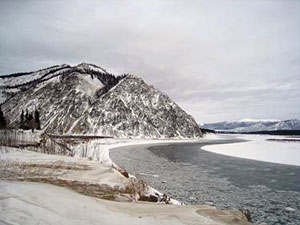Yukon River Area
Subsistence Fishing
Overview

Beginning in British Columbia, the Yukon River is 1,980 miles long, the third longest in North America, and flows through thick forests, tundra, and mountain ranges before empting into the Bering Sea. In the Athabascan language of Gwich'in, Yukon means "great river" speaking to the sheer scale and importance of it. The Athabascan people of interior Alaska have fished from and lived along the Yukon River for millennia making it an integral part of subsistence in Alaska. Every summer thousands of salmon swim up the Yukon in hopes of reaching their spawning grounds. Historically the Yukon River has played an important role in the fur trade and gold rush of the mid and late nineteenth century serving as a principle means of transportation. The river continued to do so until the 1950's when roads and airstrips began replacing barges as the most convenient method of transportation for people living and working along the river. Today the Yukon River passes through both state and federal land and is, as a result, subject to varying regulation oversight concerning subsistence, commercial and sport fishing.
